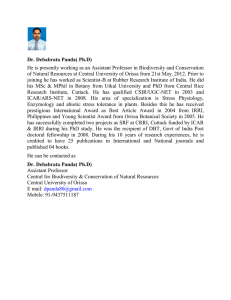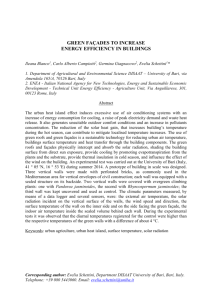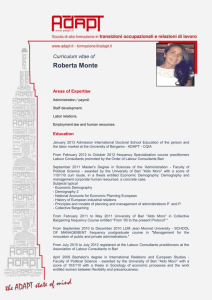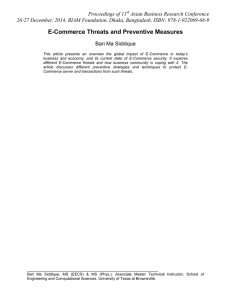Freedom Movement in Jajpur
advertisement
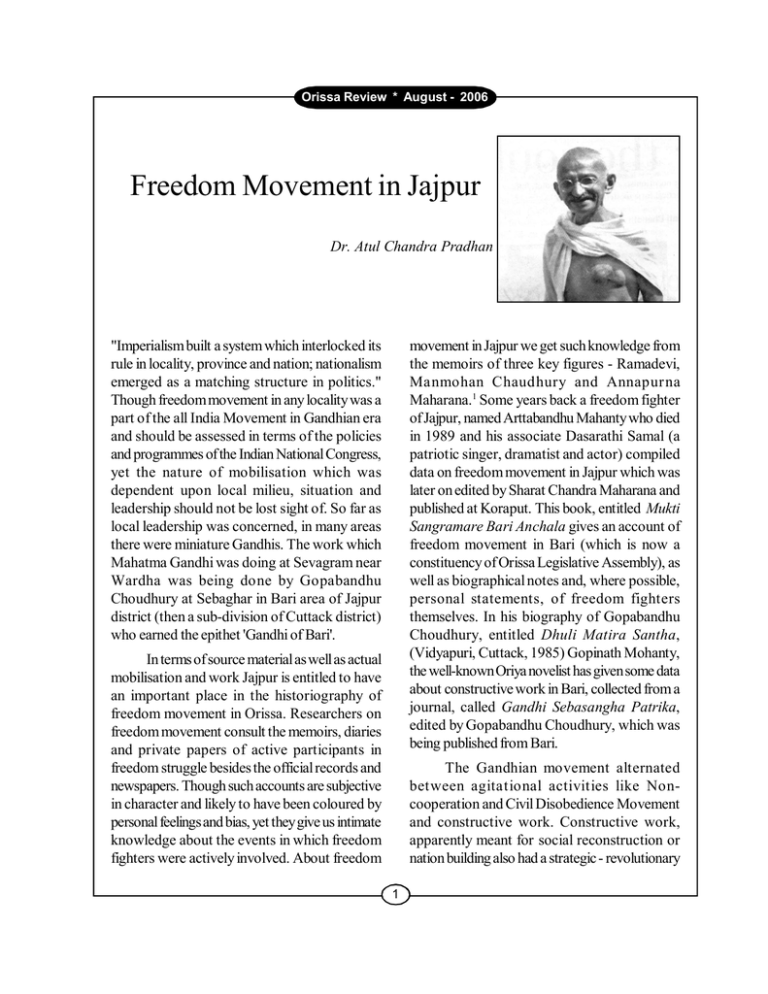
Orissa Review * August - 2006 Freedom Movement in Jajpur Dr. Atul Chandra Pradhan movement in Jajpur we get such knowledge from the memoirs of three key figures - Ramadevi, Manmohan Chaudhury and Annapurna Maharana.1 Some years back a freedom fighter of Jajpur, named Arttabandhu Mahanty who died in 1989 and his associate Dasarathi Samal (a patriotic singer, dramatist and actor) compiled data on freedom movement in Jajpur which was later on edited by Sharat Chandra Maharana and published at Koraput. This book, entitled Mukti Sangramare Bari Anchala gives an account of freedom movement in Bari (which is now a constituency of Orissa Legislative Assembly), as well as biographical notes and, where possible, personal statements, of freedom fighters themselves. In his biography of Gopabandhu Choudhury, entitled Dhuli Matira Santha, (Vidyapuri, Cuttack, 1985) Gopinath Mohanty, the well-known Oriya novelist has given some data about constructive work in Bari, collected from a journal, called Gandhi Sebasangha Patrika, edited by Gopabandhu Choudhury, which was being published from Bari. "Imperialism built a system which interlocked its rule in locality, province and nation; nationalism emerged as a matching structure in politics." Though freedom movement in any locality was a part of the all India Movement in Gandhian era and should be assessed in terms of the policies and programmes of the Indian National Congress, yet the nature of mobilisation which was dependent upon local milieu, situation and leadership should not be lost sight of. So far as local leadership was concerned, in many areas there were miniature Gandhis. The work which Mahatma Gandhi was doing at Sevagram near Wardha was being done by Gopabandhu Choudhury at Sebaghar in Bari area of Jajpur district (then a sub-division of Cuttack district) who earned the epithet 'Gandhi of Bari'. In terms of source material as well as actual mobilisation and work Jajpur is entitled to have an important place in the historiography of freedom movement in Orissa. Researchers on freedom movement consult the memoirs, diaries and private papers of active participants in freedom struggle besides the official records and newspapers. Though such accounts are subjective in character and likely to have been coloured by personal feelings and bias, yet they give us intimate knowledge about the events in which freedom fighters were actively involved. About freedom The Gandhian movement alternated between agitational activities like Noncooperation and Civil Disobedience Movement and constructive work. Constructive work, apparently meant for social reconstruction or nation building also had a strategic - revolutionary 1 Orissa Review * August - 2006 significance, because it roused awareness among the people and the constructive workers also often took active part in agitational activities. Constructive work could be sometimes carried on within the framework of semi-authoritarian and semi-hegemonic colonial government. For example, after the inauguration of provincial autonomy experiment in Gandhian scheme of Basic Education was launched with Government approval.2 the end of his Harijan padayatra in Orissa, at Bhadrak, he advised Congress workers to go back to villages. In response to this advice while Krupasindhu Hota and Gunanidhi Mahanty took up work in Beraboi village near Delang railway station, and in Dadha village near Barang railway station respectively Gopabandhu Chaudhury, and Ramadevi chose as the area of their work Bari, the flood-prone area, situated between the Kharswan and Brahmani rivers, where Chaudhury had done relief work as deputy magistrate during the days of Non-cooperation Movement. In August 1934, when the river Brahmani was full Gopabandhu and Ramadevi with a band of seven young women (Sushila Devi, Mangala, Shova, Godavari, Manika, Tulasi and Annapurna) came by boat to Bari, leaving behind his weeping old mother and other family members at Bakhrabad, Cuttack. Initially they stayed in the choupatty of Baman Charan Das, a local Zamindar of the Bagda village and later established their Ashram in a mud-built thatched house in a plot of land donated by this zamindar. The Ashram was named as Sebaghar (abode of service) by Mahatma Gandhi. Against the background of all-India nationalist movement, the movement in Jajpur district can be divided into three phases - 193034, 1934-39 and 1940-45. In 1930 Ramadevi addressed a large gathering in Bari. During the Civil Disobedience Movement some meetings and processions were organized in Jajpur. Some people engaged themselves in such activities as opium-picketting and cutting of date trees. Prominent among those who participated in Civil Disobedience Movement at Jajpur were Balaram Pati, Bipin Bihari Mahanty, Gadadhar Dutta, Padmanabha Roy and Bhagaban Sahu. In 1931, for the A.I.C.C. Session, proposed to be held at Puri, volunteers were recruited from Jajpur district, particularly from Bari. That Session could not be held because of resumption of Civil Disobedience Movement by Congress soon after Mahatma Gandhi's return from the second session of Round Table Conference and the volunteers, recruited at Bari, among whom there were a number of women such as Krushna Kamini Devi, Pramila Sundari Devi, Nirupama Devi, Hiranmayi Devi and Priyambada Devi participated in the resumed Civil Disobedience Movement and went to jail. While Gandhians took up constructive work in villages, the Congress Socialists started peasant movement in the villages. They tried to organise the peasants as a class and set them against the Zamindars, as they aimed at abolition of zamindary. In Sukinda, Dharmasala and Gadamadhupur the socialists organised the non-tribal and tribal peasants. Nabakrushna Chaudhury, Malatidevi, Gouranga Charan Das and Surendra Nath Dwivedy addressed peasants in these areas. In Dharmasala there were local peasant leaders like Paramananda Mahanty and Baladeva Lala. On 1 and 2 September 1938 Cuttack district peasant conference was held at Jenapur. The second day of the conference was celebrated as 'Dhenkanal Day'. On that day After the withdrawal of Civil Disobedience Movement Gandhi advised Congressmen all over the country to take up rural reconstruction. At 2 Orissa Review * August - 2006 discussions. Some girls, mostly daughters of Congressmen were coming to Sevaghar for receiving training on constructive work. In August 1938, according to Gandhi Seva Sangha Patrika there were ten woman trainees in Sevaghar out of whom three were workers wives.6 Sevaghar was surrounded by Harijan villages. Bari area also had a considerable Harijan population, most of whom were tenants at will and exploited by the zamindars. The Sevaghar activities roused self confidence among the Harijan tenants who learnt to shed fear of zamindars. Some Harijans like Akrur Jena, Ratnakar Jena, Arjun Jena, Bhima Jena and Sounti Mallik became active participants in freedom movement. The Sevaghar workers - Binod Kanungo and Surendra Pattanayak worked in the Harijan villages. The Harijans were allowed to enter the family temple of the zamindar Baman Charan Das. thousands of peasants from Dhenkanal attended the conference. The Jenapur rally gave momentum to the Prajamandal Movement in Dhenkanal State. While the socialists were mobilising the peasants against zamindars, the Gandhian constructive workers were giving moral support to the oppressed peasants some of whom happened to be untouchable Hindus (Harijans) so that they would be able to withstand the zamindars oppression on their own. The Gandhians also tried to settle disputes between the zamindars and peasants in amicable ways. They were able to settle the long-standing dispute between the Ratnagiri zamindar and his tenants.3 The very presence and activities of the Gandhians created a spirit of understanding between zamindars and peasants. Ramadevi writes - "We did not feel any necessity to organise the peasants against the zamindars' oppression. The latter's exploit ation and oppression ceased automatically."4 A local Congress worker observes; "Ever since Gopabandhu came to Bari all oppression has been stopped, and people have become courageous."5 The experiments in basic education was quite popular in Bari. Some people donated lands for basic schools. The free atmosphere of basic schools was liked by the students. They were not afraid of their teachers as in ordinary primary schools.7 The schools were attended by boys and girls of all castes, caste Hindu as well as Harijan, though sometimes the caste Hindu guardians raised objection to sitting of their children with the Harijans.8 The failure of Basic Schools during the Second World War was due to the provisional nature of the scheme and withdrawal of Government's sanction from 1 March 1941. The closing of Basic Schools by the Government of Orissa which was attributed by some to the alleged 'political bias' behind this system of education and by some to Governor Hubback's personal dislike for Biswanath Das who as premier had introduced Basic Education and because of whose opposition to the appointment of I.R. Dain, the Commissioner as the acting Governor, the former could not avail Constructive work which included such items as clearing, horticulture, dairy farming, preparation of gur (out of the juice from date trees), apiculture, Khadar, tanning, removal of untouchability, spread of Hindi and communal harmony aimed at making people economically self-dependent, and society free from inequality and exploitation. It had considerable social significance so far as the uplift of women and Harijans was concerned. Most of the workers of Sevaghar were women who were more capable than male workers of working among village women because of gender identity. Village women were also coming to Sevaghar to listen to 3 Orissa Review * August - 2006 four months leave caused surprise in some circles and was considered hasty by no less a person than Sir Maurice Gwyer, the Chief Justice of India.9 In other provinces of India such as Madras, Bihar, U.P., Bombay and Central Provinces the Basic Schools were not closed in spite of resignation of Congress Ministries after the outbreak of the Second World War. After the official closing of Basic Schools Utkal Maulik Shiksha Parishad was formed with Acharya Harihar Das as President, Gopabandhu Chaudhury and Sharat Chandra Maharana as Secretary and Assistant Secretary respectively. (There were other members like Lingaraj Mishra, Laxminarayan Sahu, Radhanath Rath and Ramadevi Chaudhury etc.) and some Basic Schools were run on non-Government basis. After the launching of the Quit India Movement these schools were closed and most of the teachers and some students of these schools participated in the movement. After the release of teachers the schools were started once again. people. Popular militancy during Quit India Movement was a general phenomenon due to lack of leadership and official repression. Gandhi's call to do or die sounded militant to the people. About Gandhi's mind-set before the movement, which was communicated to Congress workers at Bari by Gopabandhu Chaudhury after the latter's return from Sevagram in July 1942 Annapurna Maharana has given the following description : Under these circumstances in July 1942 Gopababu went to Sevagram. On return he called a meeting of workers of Bari area at Sevaghar. In that meeting he told that Gandhiji is contemplating giving a call to countrymen to launch a movement. He has not yet worked out the programme of the movement. But the movement will be more severe than all others. His speech indicated that although this movement would be a non-violent one, he would not withdraw it even if acts of violence like Chaurichaura occurred. After this discussion we got mentally prepared for the movement.10 Two important features of Quit India Movement in Jajpur district are large scale mobilisation of masses and popular militancy which resulted in subversive activities. On 27 August 1942 thousands of people (ranging between 10,000 and 30,000) entered into the compound of S.D.O's office in Jajpur. In August 1942 the revolutionary mob set fire to police uniforms in 26 places, 6 revenue offices, 4 post offices, 5 excisable articles, 6 zamindari kutcheries, and 4 P.W.D. bungalows. It is held that neither Gopabandhu Chaudhury nor Ramadevi nor their close associates, Gandhians as they were, incited the people to indulge in violent activities. On 26 August 1942 at Kalamatia before four people succumbed to police guns, Annapurna Maharana was persuading the agitated mob to avoid conflict with armed policemen who had already arrested some Constructive work itself was capable of rousing the spirit of confidence and fearlessness among the people in rural areas. This is very well attested by the participation of larger number of people from Bari area in the Quit India movement as compared with other parts of Jajpur. As pointed out by Annapurna Maharana, while giving a call to Congressmen to go to villages at the end of Harijan padayatra at Bhadrak, Gandhi told them an allegory the hidden purpose of which was that by working in the villages the Congress workers could make the rural people conscious of their leonine identity. 11 Distribution of leaflets, urging people to set fire to police stations, kutcheries, police uniforms, violate forest laws and loot in the 4 Orissa Review * August - 2006 district. A considerable number of women, belonging to Jajpur and other districts took part in the movement at Jajpur, particularly in constructive work and Basic education programme. The constructive work at Bari brought into focus the role of women as social workers. Ramadevi became a role model for them. The following women from other areas were involved in freedom movement and constructive work in Jajpur - Ramadevi (Cuttack, Mangala Sengupta (Dacca), Sunamani Devi (Puri), Parbati Giri (Sambalpur), Kshama Mahanty (Kujang), Sumitra Devi (Puri), Rambhadevi (Bihar), Tungavidya Devi (Balasore), Krushnapriya Devi (Rajkanika), Nirmala Dutta (Remuna), Basanti Mishra (Patkura), Annapurna Maharana (Cuttack) and Annapurna Das (Balasore). houses of rich men, which was organised by such leaders as Surendra Nath Dwivedy, Nishamani Khuntia, Surendra Pattanayak, Binod Kanungo, Bhagirath Das, and Krushna Rout roused the militant spirit of people, as pointed out by Gobinda Samal, a local Congress worker.12 A number of meetings were organised by Congress workers, which made the people restless. An important legacy of freedom movement in Jajpur was the revival and continuation of Basic education in post-independence era. In 1949 fifteen students were sent to Sevagram for having post-Basic training. In 1952 a Post-Basic School was opened at Gamu near river Birupa in a 26acre plot of land, donated by a Zamindar, named Motilal. It was shifted to Ramachandrapur in October 1953. Subsequently the experiment in Basic education fizzled out for different reasons. Freedom movement in Jajpur produced some social activists such as Krushna Prasad Basu, Birakishor Roy, Bhagirathi Das, Banchhanidhi Das, Paramananda Mohanty, Bipin Bihari Mohanty, Gadadhar Dutta, Baidyanath Das, Santanu Kumar Das and Brundaban Tripathy who played important roles in public life. From other areas of the undivided Cuttack district and other districts a number of Congressmen such as Acharya Harihar Das, Krupasindhu Hota, Harekrushna Mahtab, Gunanidhi Mohanty, Rajkrushna Bose who had been assigned the task of organising Congress movement in Jajpur in Non-cooperation days by UPCC, Naba Krushna Chaudhury, Malati Chaudhury, Surendra Pattanayak, Binod Kanungo, Surendra Nath Dwivedi, Manmohan Chaudhury Sharat Chandra Maharana, Annapurna Maharana, Baikuntha Nath Mohanty, and Parvati Giri were actively associated with freedom movement in Jajpur References : 1. See Ramadevi Chaudhury, Jiban Pathe (Oriya), (Granthamandir, Cuttack, 1984); Manmohan Chaudhury, Kasturi Mrugasama (Oriya) (Kahani Prakashani, Cuttack, 1995) and Annapurna Maharana, Amruta Anubhava (Oriya) (Shiksha Sandhan), Bhubaneswar, 2005). 2. 5 On 15 June 1938, at the direction of Shyamacharan Tripathy, the Director of Public Instruction, Government of Orissa, Mahesh Chandra Pradhan (Principal of Cuttack Training College), Sharat Chandra Maharana, SubInspector of Schools, Cuttack Sadar Circle and Raghunath Mahanty of Bakhrabad, Cuttack went to Wardha for having orientation in Basic Education. Subsequently others were sent to Wardha for training in Basic Education. The Government of Orissa constituted the Board of Basic Education with Gopabandhu Chaudhury as President and Mahesh Chandra Pradhan as Secretary. Initially its office was opened in Cuttack Training College. Fifteen Basic Schools were started in Bari with the financial help from Government. On 1 June 1939, at Ramachandrapur, on the northern bank of Brahmani a training school and a Practising
![In A Big Way [A]](http://s2.studylib.net/store/data/011883176_1-dab237a4e79b9e9830b7d3064e0ad58c-300x300.png)
